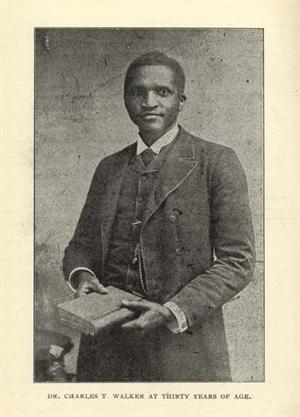-
C.T Walker School History
C.T. Walker Traditional Magnet School has a long proud history dating back to 1934. The school originally housed grades one through seven and was built to relieve overcrowding and population shifts for both black and white students in Richmond County. The building was constructed with federal financial assistance through the Works Progress Administration (WPA). The school opened with an enrollment of 1500; this was 500 more than building specifications.
As the schools were integrated in Richmond County in the early 1970's, student enrollment patterns changed. Consequently, C.T. Walker's enrollment decreased to less than 500 students. Court-ordered busing was instituted to ensure racial balances in student population and to remedy fluctuating enrollment patterns. This made it possible for students from all areas of the county to attend C.T. Walker.
C.T. Walker Traditional Magnet School, with grades kindergarten through five, was formed in 1980. It attracted black and white students throughout Richmond County and maintained a racial balance of 50/50. The magnet school concept brought changes in structural organization, teaching strategies, philosophy of teaching and learning, and expectations in both academics and discipline. With the new curriculum, policies changed dramatically. Promotion was based solely upon mastery of skills. Students were required to pass all basic courses in the curriculum for promotion. Enrollment required an equal representation of both black and white staff, as well as in the student population.
During the first year as a magnet school, C.T. Walker housed 400 students who were admitted on the basis of a lottery that was conducted by community leaders and school officials for grades kindergarten through five. Beginning with the 1981 school year, the sixth grade was added to the school structure at the behest of parents who wanted their children to continue at C.T. Walker through the middle school years. The following year seventh grade was added; the next year the eighth grade addition completed the kindergarten through eighth structure which exists today. During the 1999/2000 school term C.T. Walker celebrated its twentieth anniversary as a magnet school. Today students arrive on twenty-four buses from all areas of Richmond County and /or are transported in private vehicles. Very few students reside within walking distance of the school. Our enrollment is approximately 750 students.
Dr. Charles T. Walker
 Dr. Charles Thomas Walker was born into slavery on a plantation near Hephzibah in January 1858. He was the son of Hannah and Tom Walker. Hannah and Tom Walker were founding members of the Franklin CovenantChurch, a black Baptist church built before the Civil War on A. T. C. Walker's plantation at Hephzibah. Tom Walker was buried the day before Dr. Walker was born and his mother died in 1866, just one year after she and her children got their first taste of political freedom. Virtually nothing else is known about Dr. Walker's childhood until a hot day in June 1873, when the 15 year old was hoeing cotton. On that day, while his hoe broke the sand around the cotton stalks, Dr. Walker decided to find reconciliation with Jesus. He laid the hoe down and went back into the woods where he fasted for 4 days before seeking out his Uncle Nathan and declaring his desire to be baptized. He was baptized a month later in a nearby creek.His uncle enrolled him in the Augusta Theological Institute, housed in the basement of Springfield Baptist Church. Dr. Walker had only six dollars but he was determined to stay in school as long as he could feed himself, so he limited his meals to one each on Wednesday and Saturday. He finally ran out of money and was walking out of the school when he met Springfield's Reverend E. K. Love. Reverend Love temporarily provided Charles's room and board, and then worked with the president of the school to find him a permanent sponsor. Three men from Dayton, Ohio took sponsorship of Dr. Walker and in 1876, at the age of 18, he was licensed to preach. Two years after his ordination and upon completing his studies at Augusta Institute, he was called back to Franklin Covenant. He married Violette Franklin and they had four children, but only two of them lived to adulthood.
Dr. Charles Thomas Walker was born into slavery on a plantation near Hephzibah in January 1858. He was the son of Hannah and Tom Walker. Hannah and Tom Walker were founding members of the Franklin CovenantChurch, a black Baptist church built before the Civil War on A. T. C. Walker's plantation at Hephzibah. Tom Walker was buried the day before Dr. Walker was born and his mother died in 1866, just one year after she and her children got their first taste of political freedom. Virtually nothing else is known about Dr. Walker's childhood until a hot day in June 1873, when the 15 year old was hoeing cotton. On that day, while his hoe broke the sand around the cotton stalks, Dr. Walker decided to find reconciliation with Jesus. He laid the hoe down and went back into the woods where he fasted for 4 days before seeking out his Uncle Nathan and declaring his desire to be baptized. He was baptized a month later in a nearby creek.His uncle enrolled him in the Augusta Theological Institute, housed in the basement of Springfield Baptist Church. Dr. Walker had only six dollars but he was determined to stay in school as long as he could feed himself, so he limited his meals to one each on Wednesday and Saturday. He finally ran out of money and was walking out of the school when he met Springfield's Reverend E. K. Love. Reverend Love temporarily provided Charles's room and board, and then worked with the president of the school to find him a permanent sponsor. Three men from Dayton, Ohio took sponsorship of Dr. Walker and in 1876, at the age of 18, he was licensed to preach. Two years after his ordination and upon completing his studies at Augusta Institute, he was called back to Franklin Covenant. He married Violette Franklin and they had four children, but only two of them lived to adulthood.In 1884 at the age of only 26, he was called back to Augusta to pastor Beulah Baptist Church on Ellis Street. Within a few days he had the church renamed Tabernacle Baptist and the congregation began looking for a new church home. Property was found on Gwinnett Street, today's Laney-Walker Blvd., which was named for educator Lucy C. Laney and Reverend Walker. The congregation began raising money for the new church from Augustans, both black and white. Dr. Walker played a very active role in the city of Augusta and throughout the state. He was also very well known for his preaching across the country. In 1891, he went to visit the Holy Land for three months. He was the first black clergyman in the United States to be sponsored on such a trip by his congregation. He also toured England during this time and found out that the people there enjoyed more equal treatment than those in the U.S. He wrote letters back that were eventually published in a book entitled,A Colored Man's Trip Aboard, edited by Reverend Silas X. Floyd. Charles opened a school, the Walker Institute of Theology.
Dr. Walker did many things to help bring the black and white people in Augusta closer together. He was respected by prominent people all over the U.S. Many people came to Augusta just to hear him preach. Some of them were President
William Taft and John D. Rockefeller. In 1900, Dr. Walker moved to New York City to pastor Mt. Olivet Baptist Church. He was there for two years and built the congregation to more than 1500 members, making it the largest black church in the U.S. Then he moved back to Augusta and Tabernacle Baptist Church. He died in 1921.
Select a School...
Select a School
- A. R. Johnson
- Academy of Richmond County
- Richmond Hill Elementary School
- Barton Chapel Elementary School
- Bayvale Elementary School
- Belair Elementary school
- Blythe Elementary School
- Butler High School
- C.T. Walker Traditional Magnet
- Copeland Elementary School
- Cross Creek High School
- Cyber Academy of Excellence
- Davidson Fine Arts
- Deer Chase Elementary School
- Diamond Lakes Elementary School
- Freedom Park School
- Garrett Elementary School
- Glenn Hills Elementary School
- Glenn Hills High School
- Glenn Hills Middle School
- Goshen Elementary School
- Gracewood Elementary School
- A. Dorothy Hains Elementary School
- Hephzibah Elementary School
- Hephzibah High School
- Hephzibah Middle School
- Jenkins White Elementary School
- Jamestown Elementary School
- Lake Forest Hills Elementary School
- Lamar-Milledge Elementary School
- Lucy C. Laney High School
- McBean Elementary School
- Meadowbrook Elementary School
- Monte Sano Elementary School
- Alternative School at Morgan Road
- Murphey Middle School
- Performance Learning Center
- Pine Hill Middle School
- Richmond County Technical Career Magnet School
- eSchool
- Richmond Hill Middle School
- W.S. Hornsby Middle School
- Sue Reynolds Elementary School
- T.W. Josey High School
- Tobacco Road Elementary School
- Tutt Middle School
- W. S. Hornsby Elementary School
- Warren Road Elementary School
- Westside High School
- Wheeless Road Elementary School
- Wilkinson Gardens Elementary School
- Belair Middle School
- Marion E. Barnes Career Center
- Reaching Potential Through Manufacturing (RPM)



